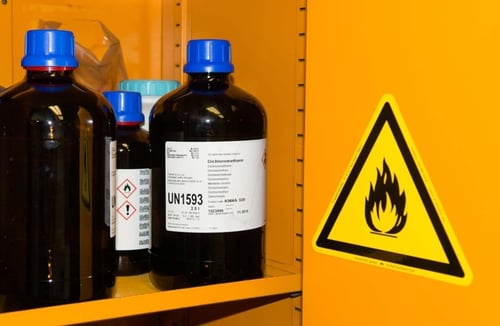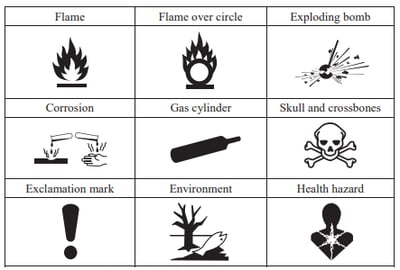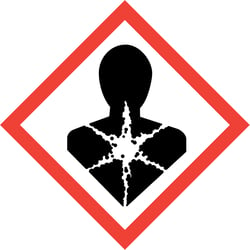When it comes to working with hazardous chemicals, you can't effectively prevent dangerous incidents from occurring if you don't fully understand what substances you're dealing with. One of the most important considerations to make when implementing hazardous chemical safety measures, is to ensure that all staff and contractors are aware of how to read chemical hazard symbols and hazard pictograms. These important symbols and pictograms alert personnel to the potential dangers associated with the individual product that is being generated, handled, stored or used. However, if you've never worked with hazchem substances before, like organic peroxides, flammable gases or corrosive chemicals, you may not fully understand the potential for danger.
To help you better understand chemicals and their associated hazards, we'll be explaining how to properly read and interpret the hazard symbols and hazard pictograms that are applicable to Australian workplaces.
Hazard Symbols in Australia
To prevent human harm and control chemical risks, hazardous chemicals need to comply with GHS 7. Otherwise known as the Globally Harmonized System of Classification and Labelling of Chemicals, the GHS provides an international standard that enables the prompt identification of chemical hazards.
The Globally Harmonised System includes pictograms, signal words and hazard statements which alert users to the specific hazards and dangers relevant to the chemical. These symbols and information are found on the chemical labels, safety data sheets (SDS) and hazardous signs that are placed around facilities carrying hazchem.

In Australia, we follow the Globally Harmonised System (GHS) that allows for an internationally recognised system of chemical labels and safety sheet information.
Why are Chemical Symbols Important for Safety?
Chemicals provide us the opportunity to create a better way of conducting business. Whether it’s enabling greater sanitisation practices or the implementation of superior manufacturing solutions, hazardous chemicals can provide an extremely effective product to meet the needs of industry. However, it’s important to remember that there is also the potential for these hazardous chemicals to negatively impact on human health or the environment.
Due to this concern, the Globally Harmonised System has been developed to provide information on chemical identities and hazards, so that protective measures can be implemented.
By understanding the GHS hazard symbols and hazard pictograms, it enables:
- Improvements to human health and environmental conditions
- Participating countries can adopt a recognised framework for chemical information
- A reduction in testing and evaluation requirements for chemicals due to the harmonised system
- The GHS allows international trade to be safer through a harmonised system of labelling and safety data sheet information
IMPORTANT: The goal of the Globally Harmonised System is to accurately identify the intrinsic hazards of substances and mixtures, so the hazard information can be effectively conveyed to consumers, workers, transport workers and emergency responders.
What are the Elements?
There are many elements that make up a chemical label or the information in a safety data sheet, including:
- Hazard symbols
- Hazard pictograms
- Signal word
- Hazard statements
- Precautionary statements
Together, these elements provide instantly recognisable hazard warnings for users, so measures can be put in place to control the risk of fire, explosion, human harm, chemical reactions, corrosion or other chemical safety issues.
REMEMBER: If there’s any further questions regarding the symbols, pictograms or chemical labelling, the detailed information in the safety data sheet for that specific chemical product should be consulted. Ensure you have the correct chemical hazard sign clearly displayed in your workplace to alert staff to the dangers associated with your substances.
What are GHS Symbols?
Hazard symbols are standardised under the GHS and include visual representations of various hazards that are associated with the products’ hazard classes. Any existing or new hazard symbols will be detailed in the latest GHS.
The chemical’s hazards that may be illustrated through the GHS symbols are:
Flame
This flame hazard symbol shows that the substance is flammable, self-heating or reactive, therefore precautions to prevent ignition must be taken when handling or storing this substance.
Flame Over Circle
Chemicals which are oxidisers will feature this symbol of a flame above a circle. Make sure you don’t confuse the flame and the flame over circle images, as they relate to different hazards.
Exploding Bomb
One of the most easily recognised symbols, these substances or gases carry an explosion risk. This symbol represents an extreme hazard level that must be controlled to maintain safety.
Corrosion
The corrosion symbol identifies the corrosive properties of that chemical, which could harm people, property or the environment.
Gas Cylinder
This simple symbol is for chemicals which are stored under pressure, such as a toxic, corrosive or flammable gas stored in a gas cylinder.
Skull & Crossbones
Acutely toxic chemicals will feature this skull and crossbones symbol, which illustrates the potential for serious harm or fatalities due to life-threatening chemical properties.
Exclamation Mark
Chemicals with low level toxicity. The exclamation mark is designated to chemicals which may irritate eyes or skin.
Environment
This symbol displays a dead fish near a poisoned tree and water. When chemicals have this environment symbol, it denotes the potential for environmental harm if the chemical is accidentally released.
Health Hazard
Featuring a human head and partial torso with a star-like pattern in the middle, this symbol will appear on chemicals that present a hazard to human health.
See the GHS standard symbols in the below diagram.

GHS symbols as per Section 1.4.10.3 of the 7th revised edition.
What are GHS Pictograms?
Pictograms, while also a visual representation of a hazard, are more complex than GHS symbols. Pictograms include the symbol as well as other graphic elements, to provide more detailed hazard information to the user.
In most circumstances, pictograms will have a red border around the symbol, as well as text that relates to the specific hazard.
An example of a basic pictogram for a chemical with health hazards is featured below:

See the full list of pictograms used in Australia on Safe Work Australia's website.
Understanding the Signal Word
Signal words are single words that are appropriate for the hazard class of the chemical. These words will be either: DANGER or WARNING.
One of these signal words will be assigned to the chemical label, with DANGER denoting more severe hazard categories, while WARNING is used for substances with less severe hazards.
As these words are easily recognisable and understood, they are an important part of the GHS, giving users an instant understanding of the severity of the hazard.
REMEMBER: The pictograms, signal word and hazard statements will all be located together on the chemical label for ease of reference.
Interpreting Hazard Statements
The hazard statement explains the nature of the hazards and, where appropriate, the degree of hazard associated with the chemical. The statement will be in bold on the label, so it’s easily read by users.
See Safe Work Australia's downloadable PDF to learn more about classification and labelling for workplace hazardous chemicals, including the relevant hazard statements. Access your copy here.
Reading Precautionary Statements
Precautionary statements may include a phrase and/or pictogram that denotes how the product should be used or stored. This precautionary information will describe recommended chemical safety measures that need to be taken to control the hazards associated with the product, whether it’s limiting workers’ exposure to chemicals, the implementation of proper storage or changes in chemical handling procedures.
How to Train Staff to Understand the Physical and Health Hazard
Within Section 1.4.9 of GHS 7, there are details about the importance of training staff to understand how hazard information is communicated.

Unless staff have been educated about how to read the pictograms and information on labels and the safety data sheets, they won't be able to prevent dangerous incidents from occuring.
When staff are required to interpret chemical labels and/or safety data sheets, they must receive the necessary education and training that is suitable for the nature of the individual’s work, as well as their likelihood of exposure. Training is required for any person who is using or working with hazardous substances, including staff, emergency responders and those that are associated with the supply or transport of these chemicals.
REMEMBER: In Australia, the Australian Dangerous Goods (ADG) Code is the recognised standard for chemical hazard identification for those involved with the transport of hazardous chemicals and dangerous goods. Refer to the ADG Code for further information on transporting Hazchem or DG products.
Hazard Classes, Health Hazards and other Vital Information
For the safety of staff, the community and the environment, it’s so important that the hazard pictograms and statements are understood and actioned. This harmonised chemical information, which is conveyed through chemical labels and safety data sheets, allows everyone associated with Hazchem to decrease the likelihood of potential dangers.
By providing standardised information through the implementation of the GHS, Australia and other participating countries can better communicate the potential danger that is associated with a chemical product. To learn more about taking the next steps towards reducing chemical hazards in your workplace, why not purchase our Ultimate DG Storage Handbook? We can help you choose the right control measures, so you can create a safer and compliant workplace. Grab your copy now for just $6.99 plus GST.
Joining the team as a Dangerous Goods Storage Consultant, Melissa Hampton became Storemasta's Marketing Manager in late 2021. With extensive knowledge and experience in chemical compliance, Melissa is responsible for leading the Marketing team and helping shape their marketing strategy. In her spare time, you can find Melissa hiking, swimming and enjoying the great outdoors in beautiful north-west Tasmania.
